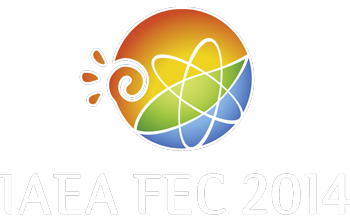Speaker
Dr
Andrey Litnovsky
(Forschungszentrum Juelich, Germany)
Description
Mirrors will be used in optical diagnostic systems of ITER to guide the light from plasma towards detectors and cameras. In the severe particle and radiation environment, the mirrors will be subjected to the erosion due to fast particles and to deposition of impurities from the plasma. These processes affect adversely the mirror reflectivity and therefore must be suppressed or mitigated at the maximum possible extent. The use of shutters and shaped diagnostic ducts for mirror protection represent the passive protection techniques. Among the active recovery techniques, in-situ cleaning of mirrors by the plasma is the most promising candidate option.
The first positive results of experiments and the predictive modeling envisage the successful suppression of deposition in the diagnostic tubes with fins trapping the impurities on their way towards the mirrors located in the end of these tubes. To benchmark the modeling predictions, cylindrical and cone-shaped diagnostic tubes were exposed in TEXTOR for about 140 hours of plasma operation. After exposure, the deposition ranging 50-150 nm was found on the mirrors located in the cylindrical tubes. No drastic suppression of deposition was observed in the cylindrical tubes with fins. At the same time, no detectable deposition was found on the mirrors located at the end of cone-shaped tubes outlining the advantages of the cone geometry.
Active cleaning by plasma sputtering was performed on molybdenum mirrors pre-coated with the aluminum film with the 100 nm thickness. Aluminum was used as proxy of beryllium in these studies. Electron-cyclotron resonance-generated plasmas were used for plasma exposures. The mirrors were biased to increase the effectiveness of plasma sputtering. During the exposure in helium plasma, the entire coating was sputtered within nine hours, leaving no trace of aluminum and leading to the full recovery of the specular reflectivity. Remarkably, the diffuse reflectivity of the mirror substrate did not increase in the wavelength range of 250-2500 nm demonstrating the complete recovery of the mirror surface by plasma sputtering of the coating without detrimental effects on the mirror itself. The analyses of passive and active mirror recovery efforts will be provided in the contribution.
| Country or International Organisation | Germany |
|---|---|
| Paper Number | FIP/P4-6 |
Author
Dr
Andrey Litnovsky
(Forschungszentrum Juelich, Germany)
Co-authors
Mr
Anatoly Panin
(Forschungszentrum Juelich)
Prof.
Christian Linsmeier
(Forschungszentrum Juelich)
Mr
David Castano Bardawil
(Forschungszentrum Juelich)
Ms
Luxherta Buzi
(Forschungszentrum Juelich)
Mrs
Maria Matveeva
(Forschungszentrum Juelich)
Dr
Tsuyoshi Akiyama
(National Institute for Fusion Science)
Dr
Vladislav Kotov
(Forschungszentrum Juelich)
Dr
Wolfgang Biel
(Forschungszentrum Juelich)
Mr
Yuri Krasikov
(Forschungszentrum Juelich)

